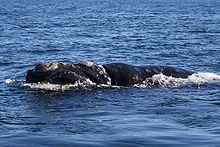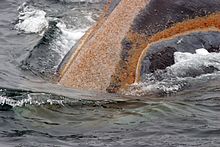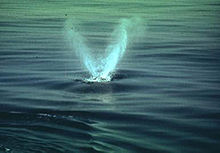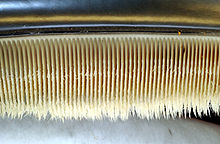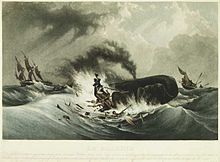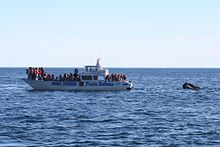
Right whale
Background Information
SOS Children volunteers helped choose articles and made other curriculum material A good way to help other children is by sponsoring a child
| Right whales | |
|---|---|
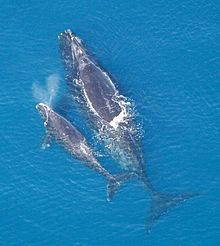 |
|
| A female North Atlantic right whale with her calf in the ocean. | |
 |
|
| Size comparison against an average human | |
| Scientific classification | |
| Kingdom: | Animalia |
| Phylum: | Chordata |
| Class: | Mammalia |
| Order: | Cetacea |
| Suborder: | Mysticeti |
| Family: | Balaenidae |
| Genus: | Eubalaena Gray, 1864 |
| Type species | |
| Balaena australis Desmoulins, 1822 |
|
| Species | |
|
|
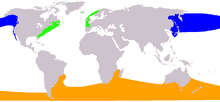 |
|
|
Ranges Eubalaena glacialis
Ranges Eubalaena australis
Ranges Eubalaena japonica
|
|
| Synonyms | |
|
|
Right whales are three species of large baleen whales of the genus Eubalaena: the North Atlantic right whale (E. glacialis), the North Pacific right whale (E. japonica) and the southern right whale (E. australis). They are classified in the family Balaenidae with the bowhead whale. Right whales have rotund bodies with arching rostrums, V-shaped blowholes and dark gray or black skin. The most distinguishing feature of a right whale is the rough patches of skin on its head which appear white due to parasitism by whale lice. Right whales can grow up to 18 m (59 ft) long and weigh up to 100 short tons (91 t; 89 long tons), significantly larger than humpbacks or grays, but smaller than blues. Although the blue whale is the largest animal on the planet, the testes of the right whale are actually ten times the size of those of the blue whale. Weighing up to 525 kg (1157 lbs), they are by far the largest of any animal on Earth.
All three species are migratory, moving to certain areas to feed or give birth. The warm equatorial waters form a barrier that prevents mixing between the northern and southern groups. Right whales tend to avoid open waters and stay close to peninsulas and bays and on continental shelves, as these areas offer greater shelter and an abundance of their preferred foods. Right whales feed mainly on zooplankton but will also consume krill and pteropods. They may forage the surface, underwater or even on the ocean bottom. During courtship, males gather into large groups to compete for a single female. Sperm competition appears to be important in mating. Gestation tends to last a year and calves are born at 1 short ton (0.91 t; 0.89 long ton) in weight and 4–6 m (13–20 ft) in length. Weaning occurs after eight months.
Because of their docile nature, their slow surface-skimming feeding behaviors, their tendencies to stay close to the coast, and their high blubber content (which makes them float when they are killed, and which produced high yields of whale oil), right whales were a preferred target for whalers, who reportedly considered them the "right" whales to hunt. The North Atlantic and western population of the North Pacific species is currently endangered, but the eastern population of the North Pacific species is critically endangered – with the population in the North Atlantic Ocean numbering in the hundreds, but in the eastern North Pacific numbering less than 50, and at risk of extinction. Both species are protected in the United States by the Endangered Species Act. The southern right whale is more abundant, numbering in the thousands. In addition to whaling, right whales are threatened by entanglements in fishing nets and collisions with ships.
Naming
A popular explanation for the name "right whales" is that they were the "right" ones to hunt, as they float when killed and often swim within sight of shore. They are quite docile, and do not tend to shy away from approaching boats. As such, they were hunted nearly to extinction during the active years of the whaling industry. This origin is apocryphal. In his history of American whaling, Eric Jay Dolin writes:
Despite this highly plausible rationale, nobody actually knows how the right whale got its name. The earliest references to the right whale offer no indication why it was called that, and some who have studied the issue point out that the word "right" in this context might just as likely be intended "to connote 'true' or 'proper,' meaning typical of the group."—E.J. Dolin, Leviathan: The History of Whaling in America, quoting a 1766 Connecticut Courant newspaper article.
Taxonomy
The right whales were first classified in the Balaena genus in 1758 by Carolus Linnaeus, who at the time considered all of the right whales (including the bowhead) as a single species. Through the 1800s and 1900s, in fact, the Balaenidae family has been the subject of great taxonometric debate. Authorities have repeatedly recategorized the three populations of right whale plus the bowhead whale, as one, two, three or four species, either in a single genus or in two separate genera. In the early whaling days, they were all thought to be a single species, Balaena mysticetus. Eventually, it was recognized that bowheads and right whales were in fact different, and John Edward Gray proposed the Eubalaena genus for the right whale in 1864. Later, morphological factors such as differences in the skull shape of northern and southern right whales indicated at least two species of right whale—one in the Northern Hemisphere, the other in the Southern Ocean. As recently as 1998, Rice, in his comprehensive and otherwise authoritative classification, Marine mammals of the world: systematics and distribution, listed just two species: Balaena glacialis (the right whales) and Balaena mysticetus (the bowheads).
In 2000, Rosenbaum et al. disagreed, based on data from their genetic study of DNA samples from each of the whale populations. Genetic evidence now clearly demonstrates that the northern and southern populations of right whale have not interbred for between 3 million and 12 million years, confirming the southern right whale is a distinct species. What some scientists found more surprising was the discovery that the Northern Hemisphere Pacific and Atlantic populations are also distinct, and that the North Pacific species is more closely related to the southern right whale than to the North Atlantic right whale.
In 2001, Brownell et al. re-evaluated the conservation status of the North Pacific right whale as a distinct species, and in 2002, the Scientific Committee of the International Whaling Commission (IWC) accepted Rosenbaum's findings, and recommended that the Eubalaena nomenclature be retained for this genus. A 2007 study by Churchill provided further evidence to conclude the three living right whale species do comprise a phylogenetic lineage, distinct from the bowhead, and are rightly classified into two separate genera.
The cladogram is a tool for visualizing and comparing the evolutionary relationships between taxa; the point where each node branches is analogous to an evolutionary branching – the diagram can be read left-to-right, much like a timeline. The following cladogram of the Balaenidae family serves to illustrate the current scientific consensus as to the relationships between the three right whales and the bowhead whale.
| Family Balaenidae | |||||||||||||||||||||
|
|||||||||||||||||||||
| The right whales, genus Eubalaena, in the family Balaenidae |
Whale lice, parasitic cyamid crustaceans that live off skin debris, offer further information through their own genetics. Because these lice reproduce much more quickly than whales, their genetic diversity is greater. Marine biologists at the University of Utah examined these louse genes and determined their hosts split into three species 5–6 million years ago, and these species were all equally abundant before whaling began in the 11th century. The communities first split because of the joining of North and South America. The rising temperatures of the equator then created a second split, into northern and southern groups, preventing them from interbreeding. "This puts an end to the long debate about whether there are three [Eubalaena] species of right whale. They really are separate beyond a doubt", Jon Seger, the project's leader, told BBC News.
Others
The pygmy right whale (Capera marginata), a much smaller whale of the Southern Hemisphere, was also included in the Balaenidae family, but has recently been found to warrant a separate family, Neobalaenidae. Yet another species of right whale was proposed by Emanuel Swedenborg in the 18th century - the so-called "Swedenborg whale". The description of this species was based on a collection of fossil bones unearthed at Norra Vånga, Sweden, in 1705 and believed to be those of giants. The bones were examined by Swedenborg, who realized they belong to a species of whale. The existence of this species has been debated, and further evidence for this species was discovered during the construction of a motorway in Strömstad, Sweden in 2009. To date, however, scientific consensus still considers Hunterius swedenborgii to be a North Atlantic right whale. According to a DNA analysis conducted by scientists, it was later confirmed that the fossil bones are actually from a Bowhead Whale.
Synonyms and common names
Due to their familiarity to whalers over a number of centuries, the right whales have had many names. These names were used throughout the world, reflecting the fact that only one species was recognized at the time. In his novel Moby-Dick, Herman Melville writes:
"Among the fishermen, the whale regularly hunted for oil is indiscriminately designated by all the following titles: The Whale; the Greenland whale; the black whale; the great whale; the true whale; the right whale. There is a deal of obscurity concerning the identity of the species thus multitudinously baptised. ... Some pretend to see a difference between the Greenland whale of the English and the Right whale of the Americans."— Melville, Moby Dick: or, The White Whale, Ch. XXXII Cetology
In fact, there was indeed a difference between the two – Melville's "Greenland whale", or "Greenland right whale", was in fact the modern-day bowhead whale, Balaena mysticetus.
The following are junior synonyms for the genus Eubalaena:
-
- Baloena Robineau, 1989
- Halibalaena Gray, 1873
- Hunterius Gray, 1866
- Hunterus Gray, 1864
- Macleayanus Marschall, 1873
- Macleayius Gray, 1865
Although the right whale is now officially in the Eubalaena genus, the type species for a genus remains as it was first described – in the case of Eubalaena the type species is Balaena australis Desmoulins, 1822.
Some of the species-level synonyms are:
-
- For E. australis
- B. antarctica Lesson, 1828
- B. antipodarum Gray, 1843
- B. glacialis Mueller, 1776
- B. glacialis australis Scheffer & Rice, 1963
- E. capensis Gray, 1866
- E. glacialis australis Tomilin, 1962
- Halibalaena britannica Gray, 1873
- Hunterus temminckii Gray, 1864
- Macleayius australiensis Gray, 1865
- For E. glacialis
- B. biscayensis Eschricht, 1860
- B. glacialis glacialis Scheffer & Rice, 1963
- B. mysticetus islandica Kerr, 1792
- B. nordcaper Lacépède, 1804
- Baloena glacialis Robineau, 1989
- E. glacialis glacialis Tomilin, 1957
- Hunterius swedenborgii Lilljeborg, 1867
- Macleayius britannicus Gray, 1870
- For E. japonica
- B. japonica Lacépède, 1804 ( basionym)
- B. sieboldii Gray, 1864
- Balaenoptera antarctica Temminck, 1841 ( lapsus for Balaena)
- E. glacialis japonica Imaizumi, 1958
- E. sieboldii Gray, 1868
Description
Unlike other whales, a right whale has distinctive callosities (roughened patches of skin) on its head, along with a broad back without a dorsal fin, occasionally with white belly patches, and a long, arching rostrum, or upper jaw, that begins above the eye. The callosities appear white due to large colonies of cyamids ( whale lice). Each individual has a unique callosities pattern. Right whales can grow up to 18 m (59 ft) long and weigh up to 100 short tons (91 t; 89 long tons), significantly larger than humpbacks or grays, but smaller than blues. An unusually large 40% of their body weight is blubber, which is of relatively low density. Consequently, unlike many other species of whale, dead right whales tend to float. Right whales swim slowly, reaching only 5 kn (9.3 km/h) at top speed. However, they are highly acrobatic and frequently breach (jump clear of the sea surface), tail-slap and lobtail.
Anatomy
Adults may be between 11–18 m (36–59 ft) in length and typically weigh 60–80 short tons (54–73 t; 54–71 long tons). The most typical lengths are 13–16 m (43–52 ft). The body is extremely thick with girth as much as 60% of total body length in some cases. The tail fluke is broad (up to 40% of body length). The North Pacific species is on average the largest of the three species. The largest specimens may weigh 100 short tons (91 t; 89 long tons). Right whales have a distinctive wide V-shaped blow, caused by the widely spaced blowholes on the top of the head. The blow rises 5 m (16 ft) above the surface. Right whales have between 200 and 300 baleen plates on each side of their mouths. These are narrow and approximately 2 m (6.6 ft) long, and are covered in very thin hairs. The plates enable the whale to filter feed.
The penis on a right whale can be up to 2.7 m (8.9 ft) – the testes, at up to 2 m (6.6 ft) in length, 78 cm (2.56 ft) in diameter, and weighing up to 525 kg (1157 lbs), are also by far the largest of any animal on Earth. The blue whale may be the largest animal on the planet, but the testicles of the right whale are actually ten times the size of those of the blue whale. They also exceed predictions in terms of relative size, as well – they are six times larger than would be expected on the basis of body mass. Together, the testicles make up nearly 1% of the right whale's total body weight. This strongly suggests sperm competition is important in mating, which correlates to the fact that right whales are highly promiscuous.
Life history and ecology
Courtship and reproduction
During the mating season, which can occur at any time in the North Atlantic, right whales gather into "surface-active groups" made up of as many as 20 males consorting a single female. The female has her belly to the surface while the males stroke her with their flippers or keep her underwater. The males do not compete as aggressively against each other as male humpbacks. The female may not become pregnant but she is still able to assess the condition of potential mates. The mean age of first parturition in North Atlantic right whales is estimated at between 7.5 and 9 years. Females breed every 3–4 years. Both reproduction and calving take place during the winter months. Calves are approximately 1 short ton (0.91 t; 0.89 long ton) in weight and 4–6 m (13–20 ft) in length at birth following a gestation period of 1 year. The right whale grows rapidly in its first year, typically doubling in length. Weaning occurs after eight months to one year and the growth rate in later years is not well understood—it may be highly dependent on whether a calf stays with its mother for a second year.
Lifespan
Very little is known about the life span of right whales. One of the few well-documented cases is of a female North Atlantic right whale that was photographed with a baby in 1935, then photographed again in 1959, 1980, 1985, and 1992. Consistent callosity patterns ensured it was the same animal. She was last photographed in 1995 with a seemingly fatal head wound, presumably from a ship strike. By conservative estimates (e.g. she was a new mother who had just reached sexual maturity in 1935), she was nearly 70 years of age, if not older. Research on the closely related bowhead whale suggests this lifespan is not uncommon and may even be exceeded.
Feeding and predation
The right whales' diets consist primarily of zooplankton, primarily the tiny crustaceans called copepods, as well as krill, and pteropods, although they are occasionally opportunistic feeders. As with other baleens, they feed by filtering prey from the water. They swim with an open mouth, filling it with water and prey. The whale then expels the water, using its baleen plates to retain the prey. Prey must occur in sufficient numbers to trigger the whale's interest, be large enough that the baleen plates can filter it, and be slow enough that it cannot escape. The "skimming" may take place on the surface, underwater, or even at the ocean's bottom, indicated by mud occasionally observed on right whales' bodies.
The right whales' three known predators are humans, orcas, and sharks. When danger lurks, a group of right whales may cluster into a circle, and thrash their outwards-pointing tails. They may also head for shallow water, which sometimes proves to be an ineffective defense. The sheer size of this animal is its best defense, although young calves are the most vulnerable to orca and shark attacks.
Range and habitat
The three Eubalaena species inhabit three distinct areas of the globe: the North Atlantic in the western Atlantic Ocean, the North Pacific in a band from Japan to Alaska and all areas of the Southern Ocean. The whales can only cope with the moderate temperatures found between 20 and 60 degrees in latitude. The warm equatorial waters form a barrier that prevents mixing between the northern and southern groups. Although the southern species in particular must travel across open ocean to reach its feeding grounds, the species is not considered to be pelagic. In general, they prefer to stay close to peninsulas and bays and on continental shelves, as these areas offer greater shelter and an abundance of their preferred foods.
Because the oceans are so large, it is very difficult to accurately gauge whale population sizes. Approximate figures:
- 400 North Atlantic right whales (Eubalaena glacialis) live in the North Atlantic;
- 23 North Pacific right whales have been identified in the eastern North Pacific (Eubalaena japonica) and
- 15,000 southern right whales (Eubalaena australis) are spread throughout the southern part of the Southern Hemisphere.
North Atlantic right whale
Almost all of the 400 North Atlantic right whales live in the western North Atlantic Ocean. In northern spring, summer and autumn, they feed in areas off the Canadian and northeast U.S. coasts in a range stretching from New York to Nova Scotia. Particularly popular feeding areas are the Bay of Fundy and Cape Cod Bay. In winter, they head south towards Georgia and Florida to give birth. There have been a smattering of sightings further east over the past few decades; several sightings were made close to Iceland in 2003. These are possibly the remains of a virtually extinct eastern Atlantic stock, but examination of old whalers' records suggests they are more likely to be strays. However, a few sightings are regular between Norway, Ireland, Spain, Portugal, the Canary Islands and even Italy and Sicily; at least the Norway individuals come from the Western stock.
North Pacific right whale
The North Pacific right whale appears to occur in two populations. The population in the eastern North Pacific/Bering Sea is extremely low, numbering about 30 individuals. A larger western population of 100-200 appears to be surviving in the Sea of Okhotsk, but very little is known about this population. Thus, the two northern right whale species are the most endangered of all large whales and two of the most endangered animal species in the world. Based on current population density trends, both species are predicted to become extinct within 200 years. The Pacific species was historically found in summer from the Sea of Okhotsk in the west to the Gulf of Alaska in the east, generally north of 50°N. Today, sightings are very rare and generally occur in the mouth of the Sea of Okhotsk and in the eastern Bering Sea. Although this species is very likely to be migratory like the other two species, its movement patterns are not known.
Southern right whale
The last major population review of southern right whales by the International Whaling Commission was in 1998. Researchers used data about adult female populations from three surveys (one in each of Argentina, South Africa and Australia) and extrapolated to include unsurveyed areas and estimated counts of males and calves (using available male:female and adult:calf ratios), giving an estimated 1997 population of 7,500 animals. More recent data from 2007 indicate those survey areas have shown evidence of strong recovery, with a population approaching twice that of a decade earlier. However, other breeding populations are still very small, and data are insufficient to determine whether they, too, are recovering.
The southern right whale spends the summer months in the far Southern Ocean feeding, probably close to Antarctica. It migrates north in winter for breeding, and can be seen around the coasts of Argentina, Australia, Brazil, Chile, Mozambique, New Zealand and South Africa. Since hunting of the southern right whale ceased, stocks are estimated to have grown by 7% a year. The South American, South African and Australasian groups apparently intermix very little, if at all, because of the strong fidelity of mothers to their feeding and calving grounds. The mother passes these instincts to her calves.
Vocalization and hearing
Vocalizations made by right whales are not elaborate compared to those made by other whale species. The whales make groans, pops and belches typically at frequencies around 500 Hz. The purpose of the sounds is not known but may be a form of communication between whales within the same group. Northern right whales responded to sounds similar to police sirens—sounds of much higher frequency than their own. On hearing the sounds, they moved rapidly to the surface. The research was of particular interest because northern rights ignore most sounds, including those of approaching boats. Researchers speculate this information may be useful in attempts to reduce the number of ship-whale collisions or to encourage the whales to surface for ease of harvesting.
Relationship to humans
Whaling
Right whales were so named because early whalers considered them the "right" whale to hunt. In the early centuries of shore-based whaling before 1712, right whales were virtually the only catchable large whales, for three reasons:
- They often swam close to shore where they could be spotted by beach lookouts, and hunted from beach-based whaleboats.
- They are relatively slow swimmers, allowing whalers to catch up to them in their whaleboats.
- Once killed by harpoons, they were more likely to float, and thus could be retrieved. However, some did sink when killed (10-30% in the North Pacific) and were lost unless they later stranded or surfaced.
Basque people were the first to hunt right whales commercially, beginning as early as the 11th century in the Bay of Biscay. They initially sought oil, but as meat preservation technology improved, the animal was also used for food. Basque whalers reached eastern Canada by 1530 and the shores of Todos os Santos Bay (in Bahia, Brazil) by 1602. The last Basque voyages were made before the Seven Years' War (1756–1763). All attempts to revive the trade after the war failed. Basque shore whaling continued sporadically into the 19th century.
"Yankee whalers" from the new American colonies replaced the Basques. Setting out from Nantucket, Massachusetts and Long Island, New York, they took up to 100 animals in good years. By 1750, the commercial hunt of the North Atlantic right whale was basically over. The Yankee whalers moved into the South Atlantic before the end of the 18th century. The southernmost Brazilian whaling station was established in 1796, in Imbituba. Over the next hundred years, Yankee whaling spread into the Southern and Pacific Oceans, where the Americans were joined by fleets from several European nations. The beginning of the 20th century saw much greater industrialization of whaling, and the harvest grew rapidly. By 1937, there had been, according to whalers' records, 38,000 takes in the South Atlantic, 39,000 in the South Pacific, 1,300 in the Indian Ocean, and 15,000 in the North Pacific. The incompleteness of these records means the actual take was somewhat higher.
As it became clear the stocks were nearly depleted, the world banned right whaling in 1937. The ban was largely successful, although violations continued for several decades. Madeira took its last two right whales in 1968. Japan took 23 Pacific right whales in the 1940s and more under scientific permit in the 1960s. Illegal whaling continued off the coast of Brazil for many years and the Imbituba land station processed right whales until 1973. The Soviet Union illegally took at least 3,212 southern right whales during the 1950s and '60s, although it reported taking only four.
Whale watching
The southern right whale has made Hermanus, South Africa one of the world centers for whale watching. During the winter months (July–October), southern right whales come so close to the shoreline, visitors can watch whales from strategically placed hotels. The town employs a "whale crier" ( cf. town crier) to walk through the town announcing where whales have been seen. Southern right whales can also be watched at other winter breeding grounds.
In Brazil, Imbituba in Santa Catarina has been recognized as the National Right Whale Capital and holds annual Right Whale Week celebrations in September when mothers and calves are more often seen. The old whaling station there has been converted to a museum dedicated to the whales. In winter in Argentina, Península Valdés in Patagonia hosts the largest breeding population of the species, with more than 2,000 animals catalogued by the Whale Conservation Institute and Ocean Alliance.
Conservation
Both the North Atlantic and North Pacific species are listed as a "species threatened with extinction which [is] or may be affected by trade" (Appendix I) by CITES, and as "endangered" by the IUCN Red List. In the United States, the National Marine Fisheries Service (NMFS), a subagency of the National Oceanic and Atmospheric Administration (NOAA) has classified all three species as " endangered" under the Endangered Species Act. Under the Marine Mammal Protection Act, they are listed as "depleted".
The southern right whale is listed as "endangered" under the Australian Environment Protection and Biodiversity Conservation Act, as "nationally endangered" under the New Zealand Threat Classification System, as a "natural monument" by the Argentine National Congress, and as a "State Natural Monument" under the Brazilian National Endangered Species List.
The US and Brazil added new protections for right whales in the 2000s to address the two primary hazards. While environmental campaigners were, as reported in 2001, pleased about the plan's positive effects, they attempted to force the US government to do more. In particular, they advocated 12 knots (22 km/h) speed limits for ships within 40 km (25 mi) of US ports in times of high right whale presence. Citing concerns about excessive trade disruption, it did not comply. The Defenders of Wildlife, the Humane Society of the United States and the Ocean Conservancy sued the NMFS in September 2005 for "failing to protect the critically endangered North Atlantic Right Whale, which the agency acknowledges is 'the rarest of all large whale species' and which federal agencies are required to protect by both the Marine Mammal Protection Act and the Endangered Species Act", demanding emergency protection measures. According to NOAA researchers, about 83% of right whale sightings in the mid-Atlantic region occur within 20 nautical miles (37 km) of shore.
The southern right whale, listed as "endangered" by CITES and "lower risk - conservation dependent" by the IUCN, is protected in the jurisdictional waters of all countries with known breeding populations (Argentina, Australia, Brazil, Chile, New Zealand, South Africa and Uruguay). In Brazil, a federal Environmental Protection Area encompassing some 1,560 km2 (600 sq mi) and 130 km (81 mi) of coastline in Santa Catarina State was established in 2000 to protect the species' main breeding grounds in Brazil and promote whale watching.
On February 6, 2006, NOAA proposed its Strategy to Reduce Ship Strikes to North Atlantic Right Whales. The proposal, opposed by some shipping interests, limited ship speeds during calving season. The proposal was made official when on December 8, 2008, NOAA issued a press release that included the following:
- Effective January 2009, ships 65 feet (20 m) or longer are limited to 10 knots (19 km/h) in waters off New England when whales begin gathering in this area as part of their annual migration. The restriction extends to 20 nautical miles (37 km) around major mid-Atlantic ports.
- The speed restriction applies in waters off New England and the southeastern US, where whales gather seasonally:
- Southeastern US from St. Augustine, Florida to Brunswick, Georgia from Nov 15 to April 15
- Mid-Atlantic U.S. areas from Rhode Island to Georgia from Nov 1 to April 30.
- Cape Cod Bay from Jan 1 to May 15
- Off Race Point at the northern end of Cape Cod from March 1 to April 30
- Great South Channel of New England from April 1 to July 31
- Temporary voluntary speed limits in other areas or times when a group of three or more right whales is confirmed
- Scientists will assess the rule's effectiveness before the rule expires in 2013.
The Stellwagen Bank area has implemented an autobuoy program to acoustically detect right whales in the Boston Approaches and notify mariners via the Right Whale Listening Network website.
Threats
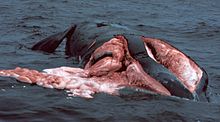
The leading cause of death among the North Atlantic right whale, which migrates through some of the world's busiest shipping lanes while journeying off the east coast of the United States and Canada, is from being struck by ships. At least 16 ship-strike deaths were reported between 1970 and 1999, and probably more remain unreported. According to NOAA, 25 of the 71 right whale deaths reported since 1970 resulted from ship strikes. Recognizing this toll could tip the delicately balanced species towards extinction, in July 1997, the U.S. NOAA introduced the Atlantic Large Whale Take Reduction Plan. A key part of the plan was the introduction of mandatory reporting of large whale sightings by ships using US ports.
A second major cause of morbidity and mortality in the North Atlantic right whale is entanglement in fishing gear. Right whales ingest plankton with wide-open mouths, risking entanglement in any rope or net fixed in the water column. Rope wraps around their upper jaws, flippers and tails. Some are able to escape, but others remain tangled. If observers notice, they can be successfully disentangled, but others die over a period of months. Animal welfare and extinction concerns align in emphasizing the harm of such entanglements.
The U.S. Navy proposed plans to create a new undersea naval training range immediately adjacent to northern right whale calving grounds in shallow waters off the Florida/Georgia border. Legal challenges by leading environmental groups including the Natural Resources Defense Council were recently denied in federal court, allowing the Navy to proceed. These rulings were made despite the extremely low numbers (as low as 313 by some) of right whales in existence at this time, and a very poor calving season.
Case Study
A comprehensive article dealing with collisions between ships and whales was published in 2001 in Marine Mammal Science. Table 2 of this article included 10 collisions with North Atlantic right whales off the eastern coast of the United States between the dates 1976 to 1996. Also in 2001, researchers from the New England Aquarium (NEA) published a paper focused on injuries and deaths of North Atlantic right whales, including 16 confirmed ship strikes during the period 1972 to 1999. Table 1 of this paper expanded the list of collisions to include Nova Scotia, Canada and the Bay of Fundy. In the first half of 2000, scientists from the Centre for Coastal Studies (Provincetown, MA) and the NEA wrote a report documenting right whale sightings in Cape Cod Bay from aerial and surface vessel surveys. Hundreds of photographs were taken and used to identify individuals by matching unique markings to those on the whales listed in the NEA North Atlantic Right Whale Catalog. Among the whales identified in and just outside Cape Cod Bay, one adult female, NEA Catalog Number #1114, sighted seven times in this area beginning in February 2000, would not live another year, tragically. An appendix in this paper chronicles the history of sightings for #1114 dating from 1981 in the Great South Channel and the Bay of Fundy, to 2000 in Cape Cod Bay. We'll return to discuss what is known about this whale, but first, some background relevant to the events that would unfold in the Bay of Fundy in the summer of 2000.
Concern over the status of the North Atlantic right whale population was expressed in the Annual Report of the International Whaling Commission (IWC) for the 51st Meeting held in Grenada in May 1999. The Scientific Committee made several important recommendations regarding the survival of these whales, which included further investigations by Canadian and American researchers into the reproductive problems within the population, and that mortality due to human causes be reported to the IWC. It was also noted in the report that there was a moratorium in place on tracking North Atlantic right whales with satellite tags, pending a study on health issues that may arise over long term tag attachment. A few right whale satellite-tagging experiments over short time periods (about 6 weeks) had taken place in the Bay of Fundy during the years 1989-1991.
An article was published in The Daily News newspaper (Halifax, Nova Scotia) on 27 February 2000 discussing the use of underwater passive acoustics to track the movements of North Atlantic right whales in the Bay of Fundy during the upcoming summer months. A team of researchers from Dalhousie University in Halifax planned to place a triangle of bottom-mounted hydrophones in the Bay of Fundy in the summer to detect and track right whales as they vocalized in their low-frequency band (300-500 Hertz). The hope was that a permanent underwater acoustic tracking system could be placed where these endangered animals frequently inhabit in the summer and fall, the raw data transmitted from this underwater installation to a shore station for processing, then the estimated whale positions sent by radio or satellite to nearby ships to assist them in avoiding collisions with the whales being tracked.
On 2 July 2000, an article was published in The Chronicle-Herald newspaper (Halifax, Nova Scotia) expressing deep concern over the lack of right whale calf sightings in the Bay of Fundy over a three-year period. A distinction was drawn between two female groups, those that feed in the Bay of Fundy and those that feed elsewhere. Plans to study the Fundy females by collecting fecal samples for pregnancy testing were discussed by a biologist with the Centre for Coastal Studies. This was consistent with one of the recommendations in the 1999 Annual Report of the IWC. Also in the newspaper story, a World Wildlife Fund spokesperson reiterated the two most important dangers to the survival of this endangered population, ship collisions and entanglements in fishing gear. Unfortunately, both would soon become Bay of Fundy environmental disasters.
A few months earlier, on 7 May 2000, a dead 7-meter whale was spotted floating just off the downtown Halifax Waterfront. Originally thought to be a minke, an expert determined it was a sei whale and speculated that is was probably killed in a collision with a ship and pushed into Halifax Harbour while stuck to the ship's round bow. On the 6 July 2000, the Canadian Navy had to move a dead minke whale from its oceanfront property at Hartlen Point, located on the Eastern Passage side of Halifax Harbour. Since the whale had an anchor still attached, it was no stretch to assume it had been towed out to sea once before.
A few days later, 9 July 2000, an article was published in The Daily News describing a more whale-friendly fishing net that would be tested in the Bay of Fundy during the summer months. Several Nova Scotia gill net fishermen would be using gear with thinner bottom-to-surface-buoy ropes that are designed to break if large whales make contact with them. This pilot project, funded mostly by the Government of Canada and the World Wildlife Fund, was expected to help reduce the incidents of right whales becoming entangled.
The front page of the Chronicle-Herald on 12 July 2000 featured the sad news that a right whale had become tangled in fishing gear in the Bay of Fundy but rescue teams from Canada and the United States were unable to assist due to adverse weather and heavy seas. Representatives from the East Coast Ecosystems Research Organization and the Center for Coastal Studies emphasized to the media that the life of every individual whale was critical to the survival of this endangered population, and that aerial searches would take place the next day, weather permitting. The whale was relocated, however, just two days later, 14 July 2000, a second right whale became entangled in fishing gear, yet a second tragic news story in the same week. Three boats were being used to help rescue one of the whales east of Grand Manan Island in the Bay of Fundy. By 17 July 2000, both whales were still in need of assistance, with one in a serious predicament with a fin pinned to its side. One of the whales, #2223 nicknamed Calvin, was fitted with a tracking device. Calvin had the remaining fishing lines removed by the Centre for Coastal Studies in 2001. Calvin appears to be doing well as it was sighted in subsequent years, including 2012, according to the NEA Catalog. A group of employees at the Fisheries Museum of the Atlantic in Lunenburg, NS adopted Calvin in 2000. The adoption fee of only $35/year helps pay for cameras for photo identification, and fuel for boats. (The fate of the second whale still requires some research before an entry can be made here).
So, by the end of July 2000 several articles had appeared in Nova Scotia newspapers concerning ship collisions with, and fishing gear entanglements of cetaceans, particularly the endangered North Atlantic right whales that visit the Bay of Fundy each year. With some of the articles making front pages, the citizens of this province were given several opportunities to become aware of the conservation efforts and initiatives underway by researchers, rescuers, fishermen, the Canadian government and several marine mammal environmental organizations.
